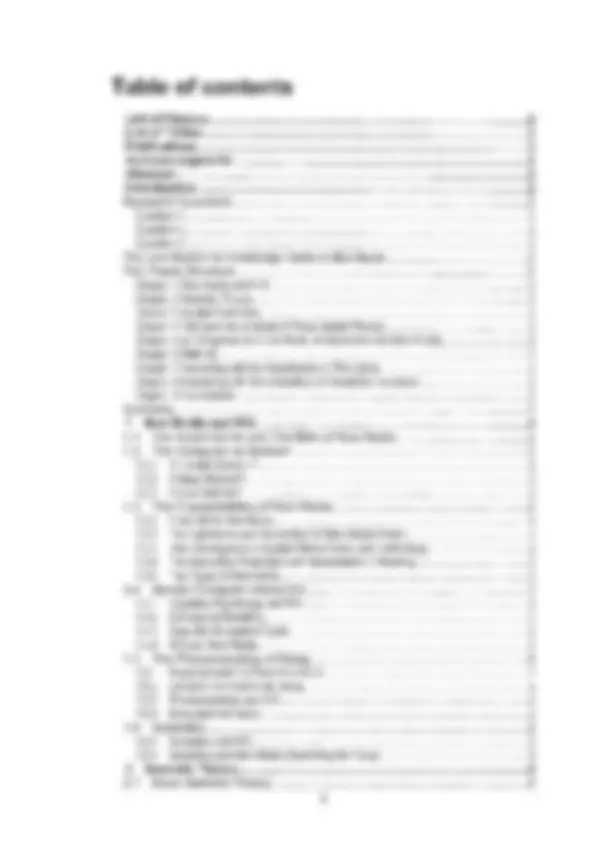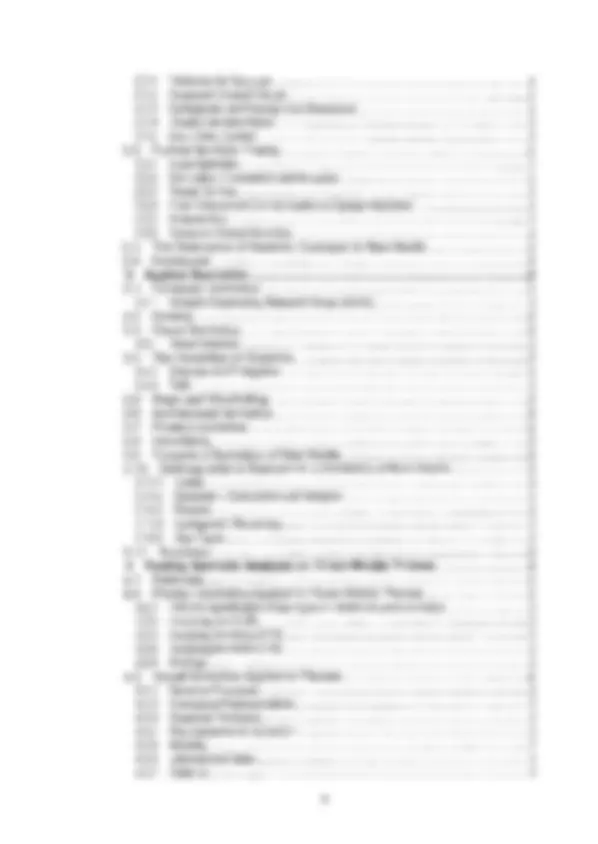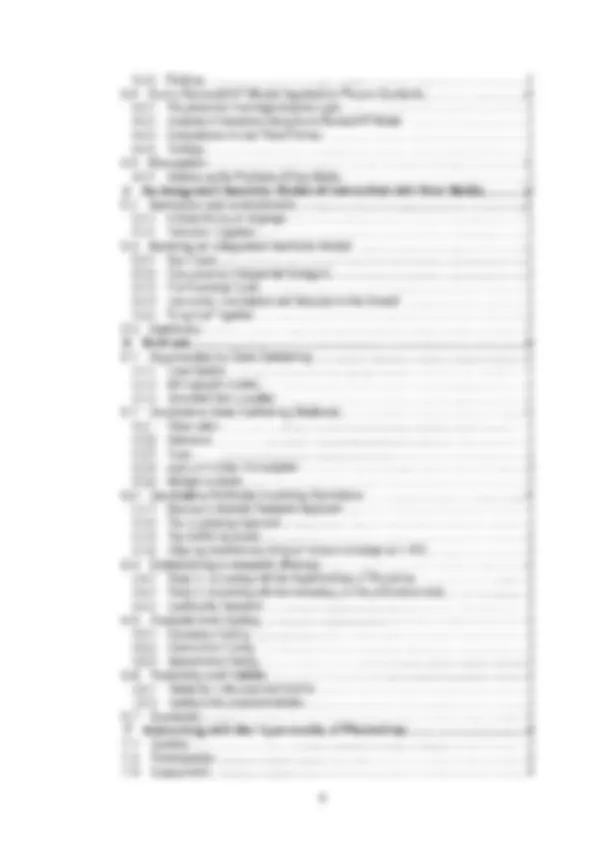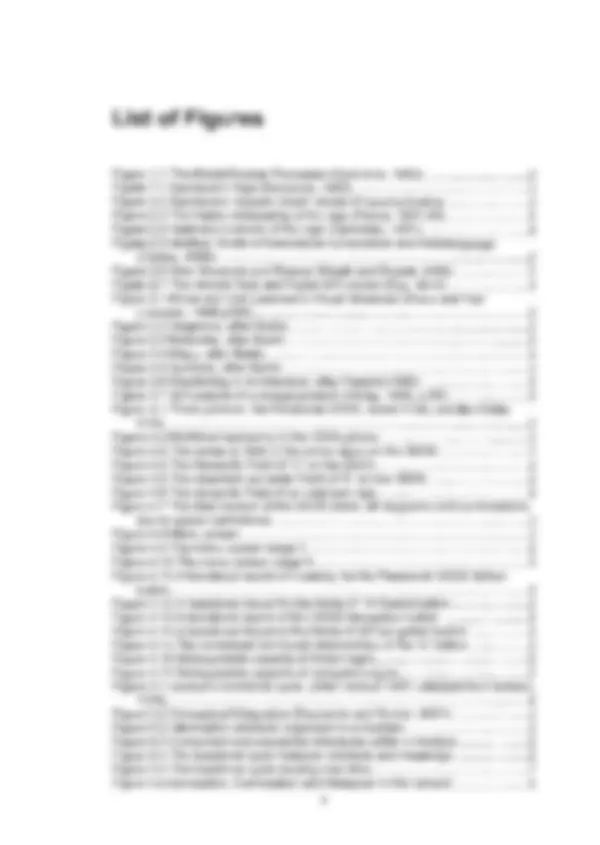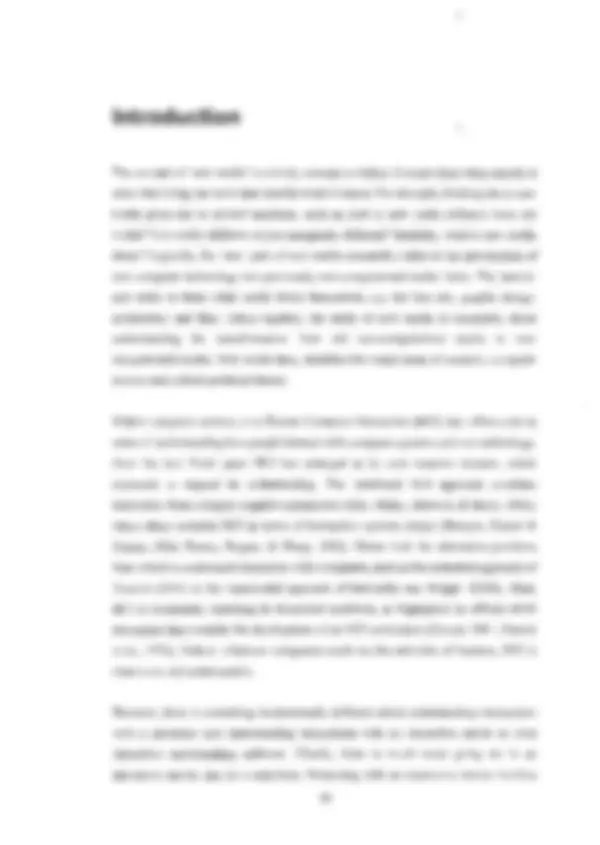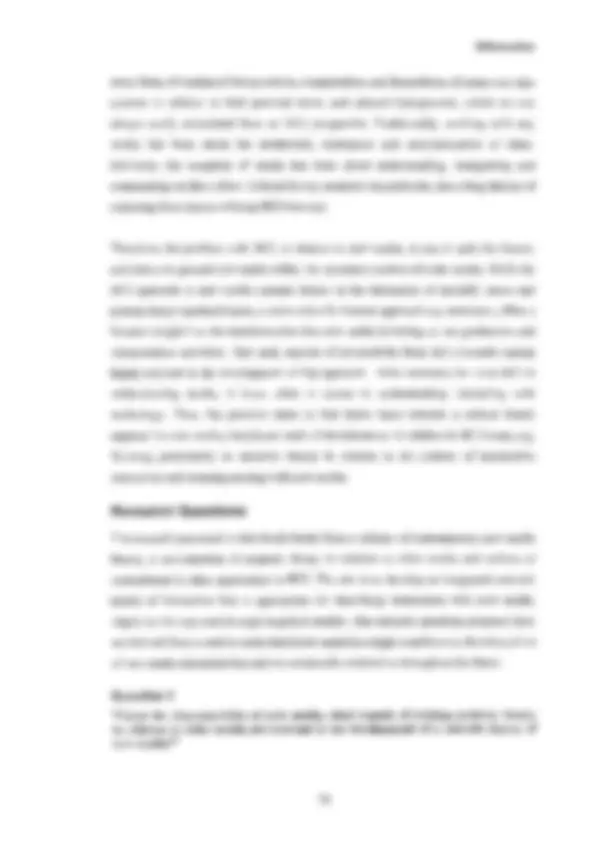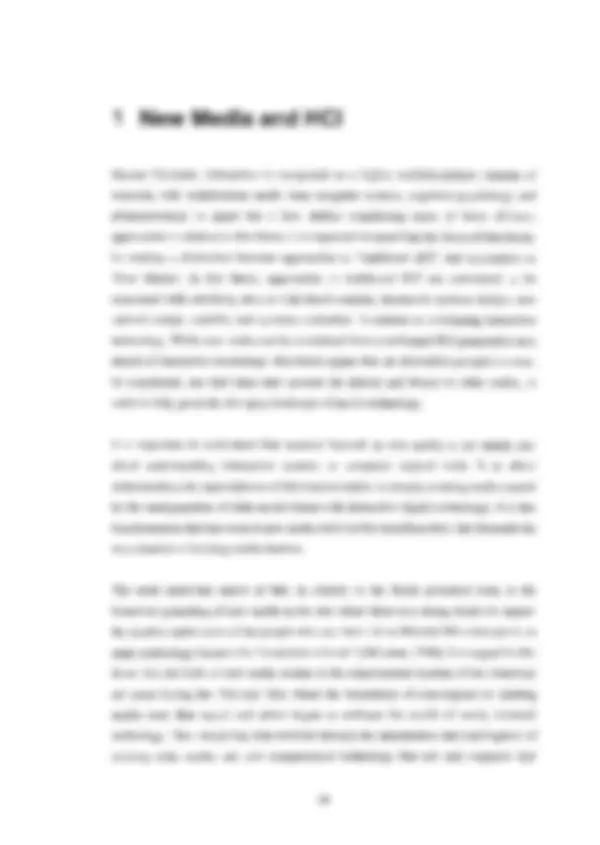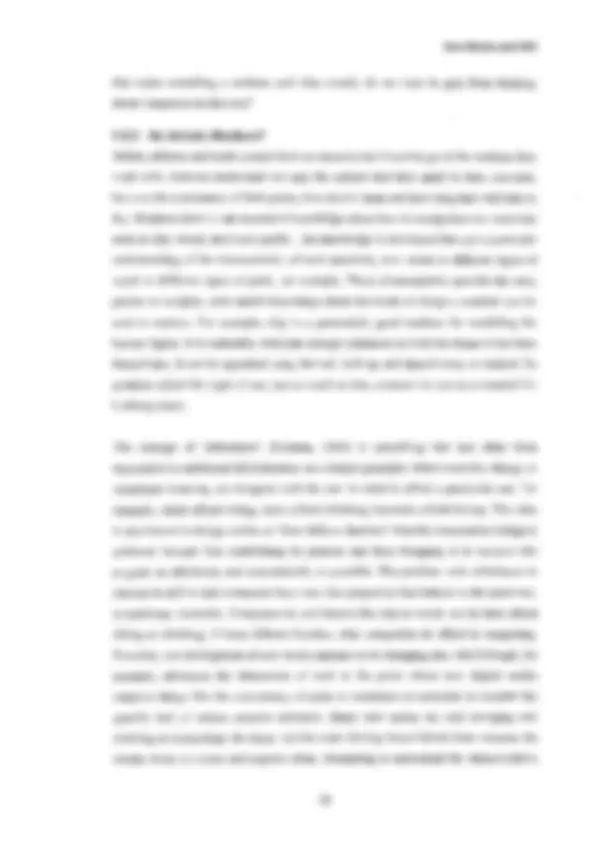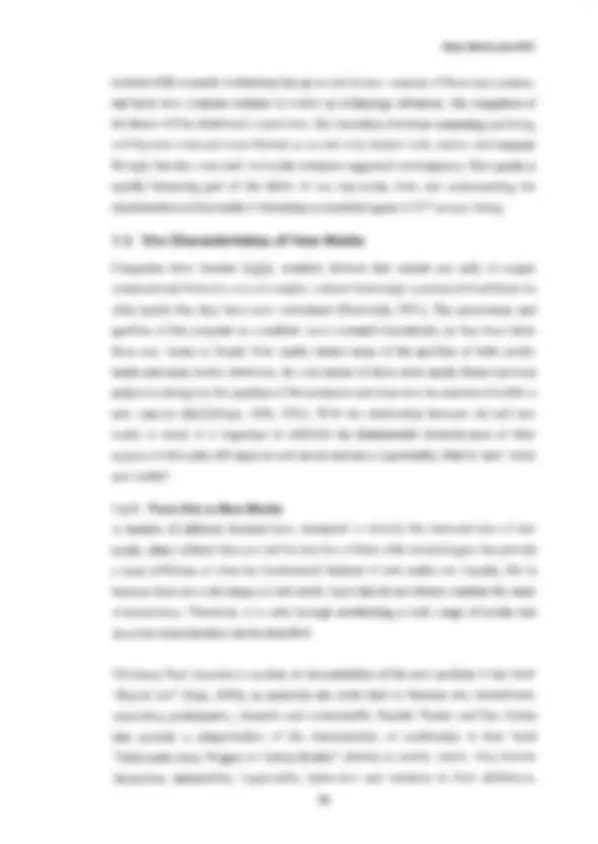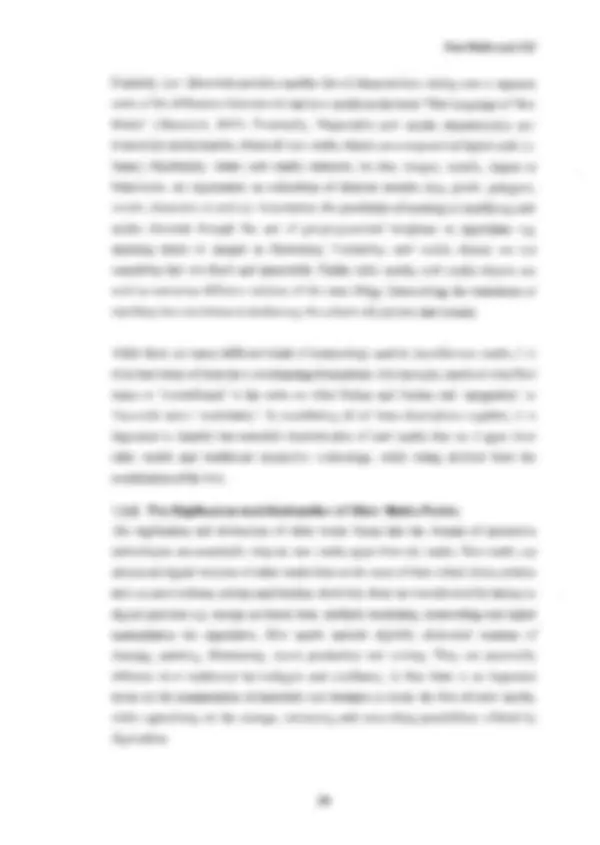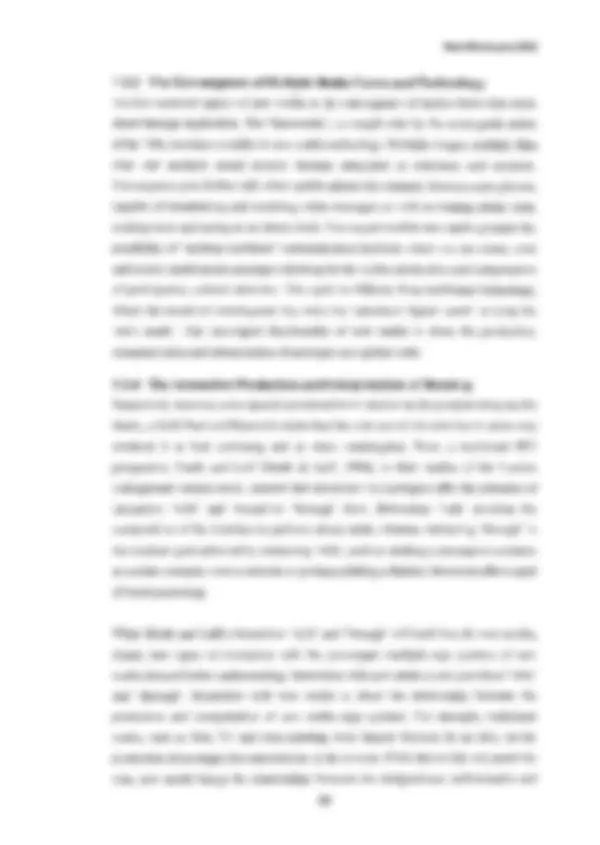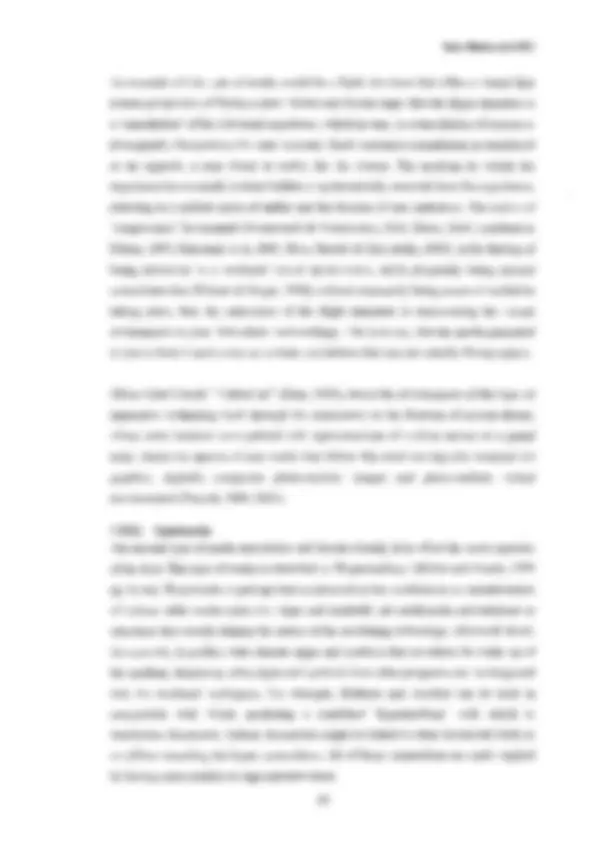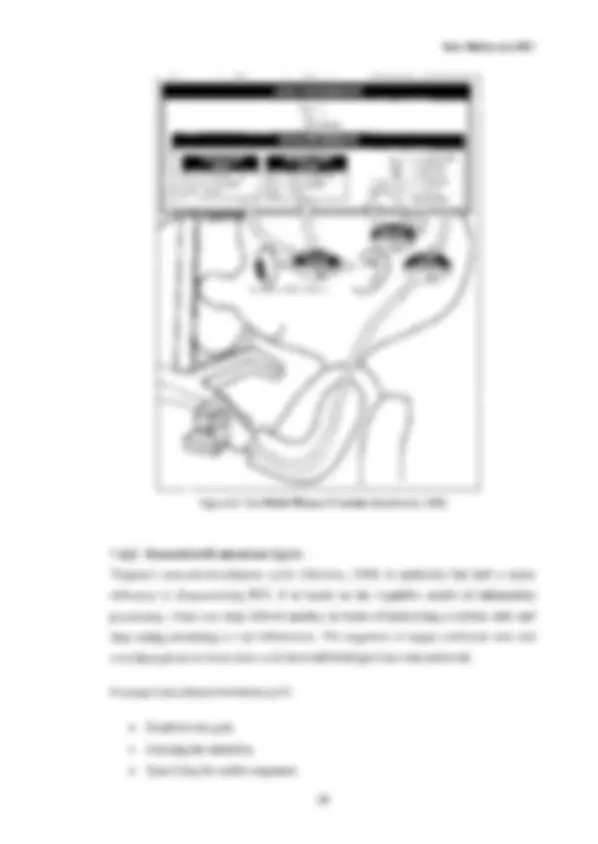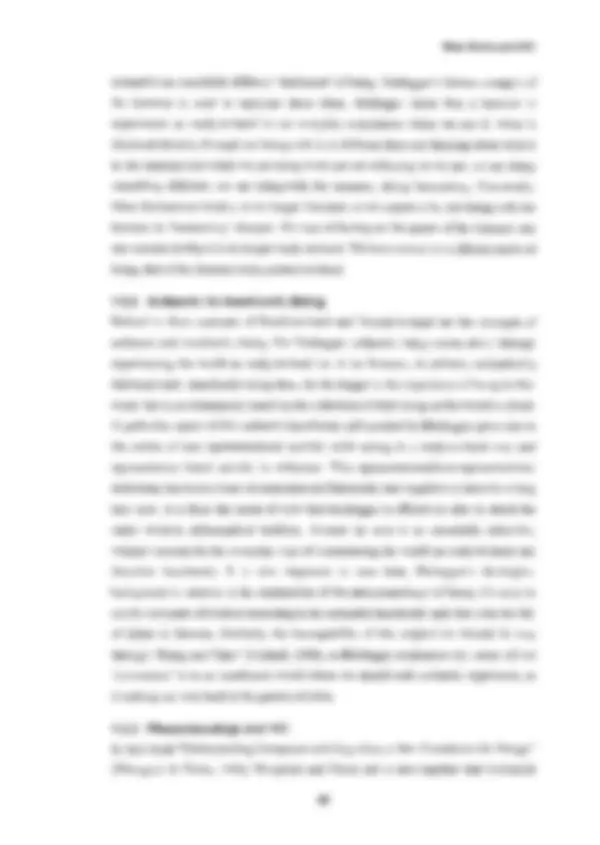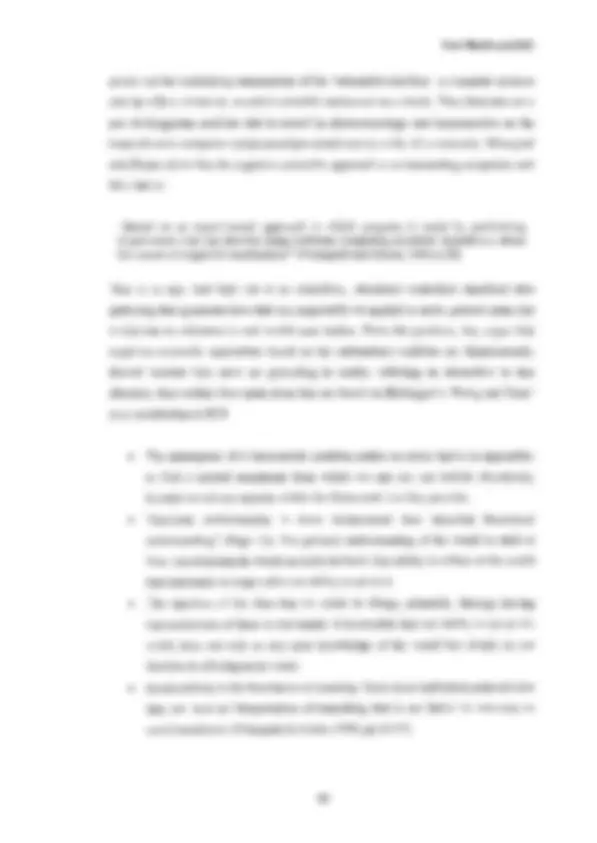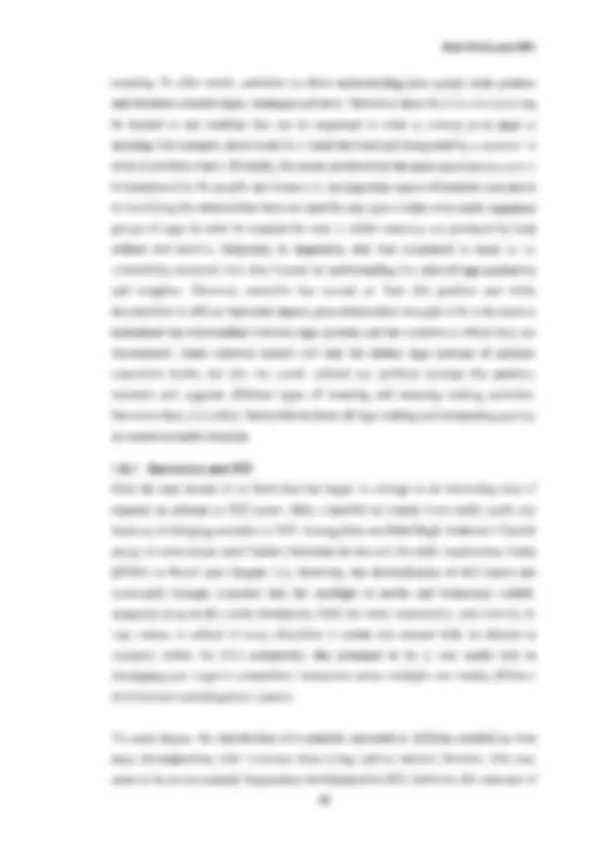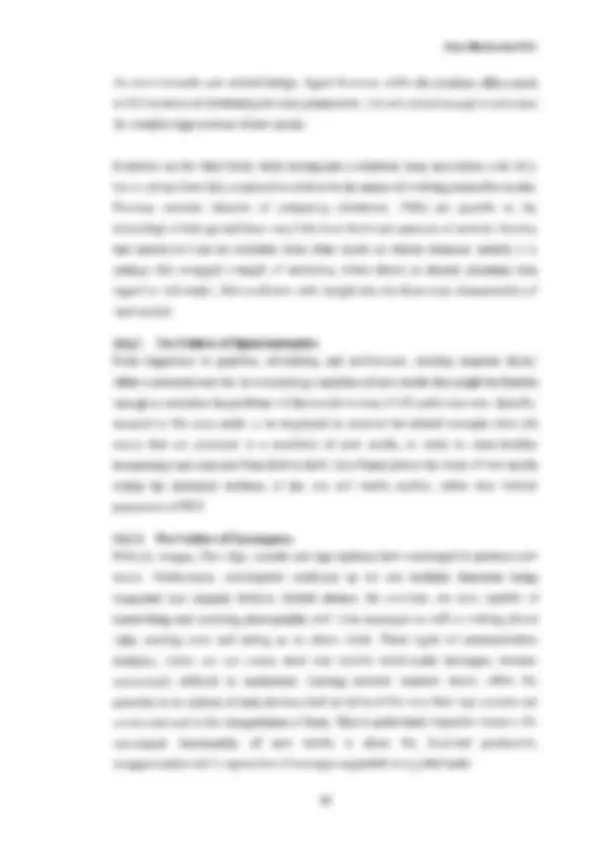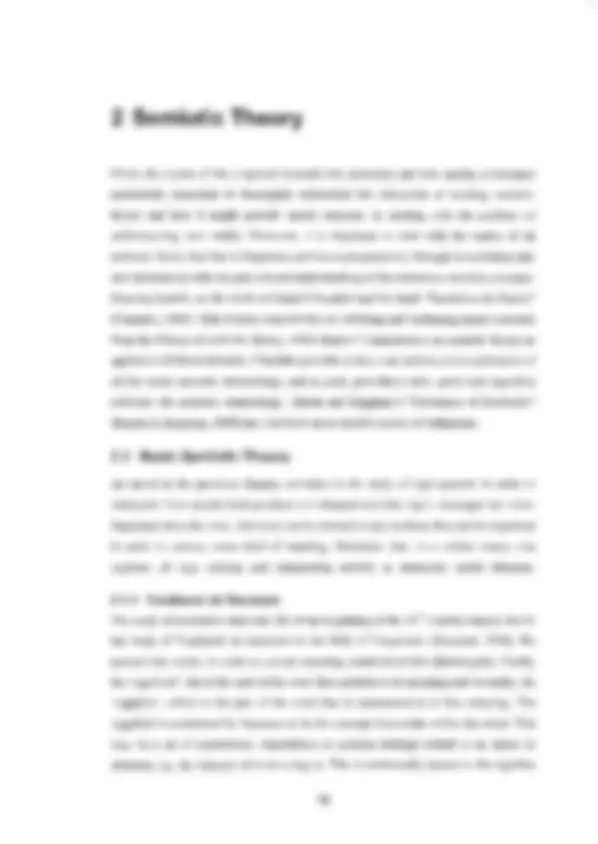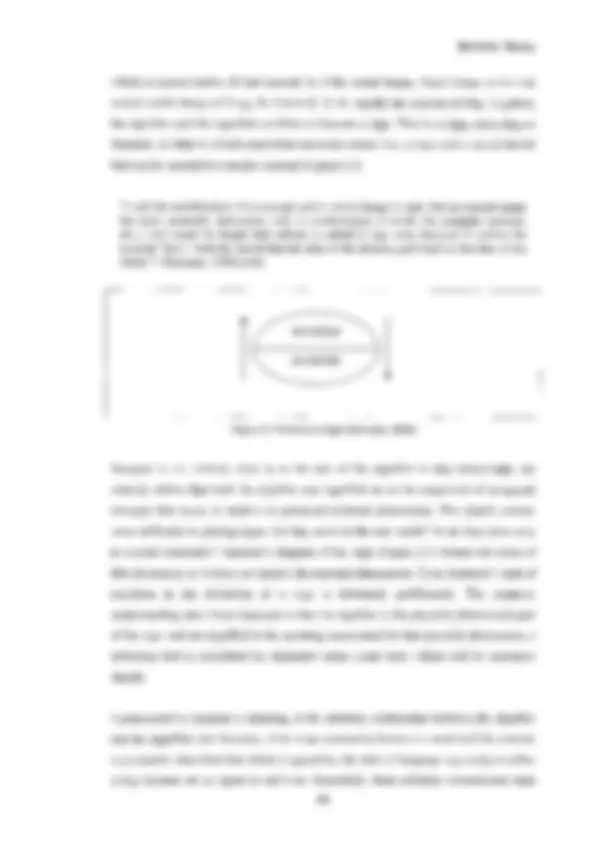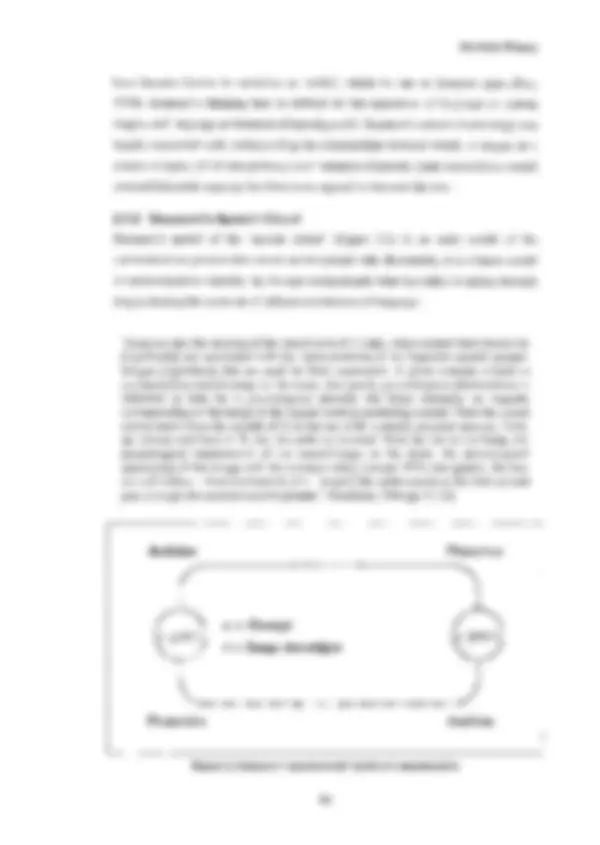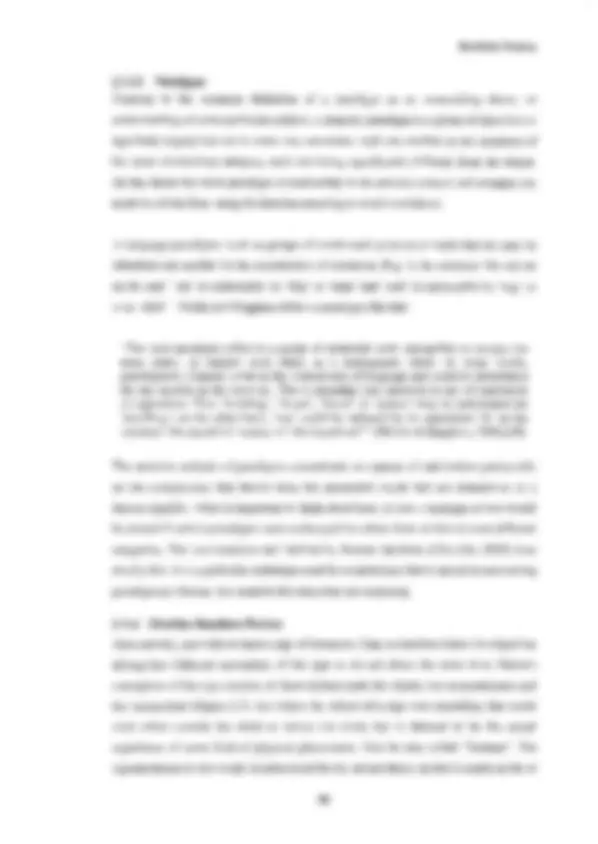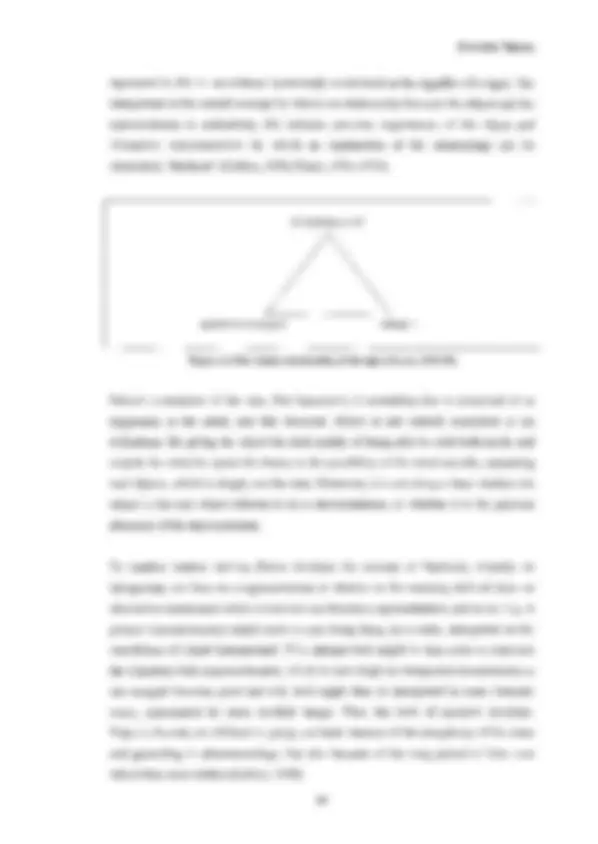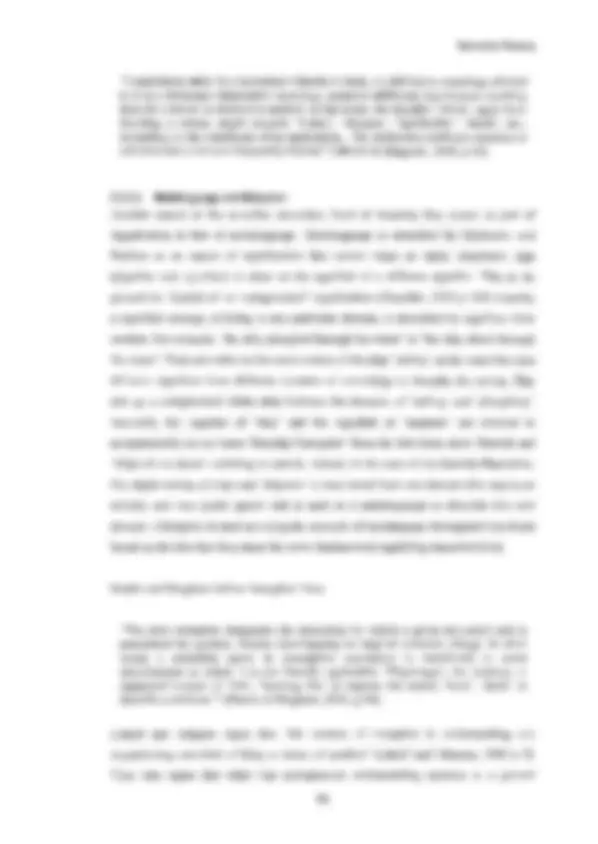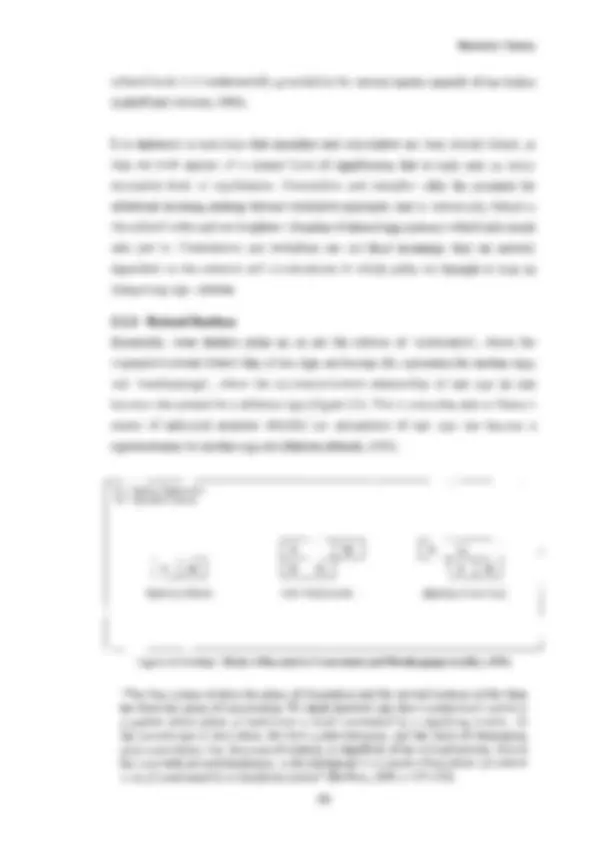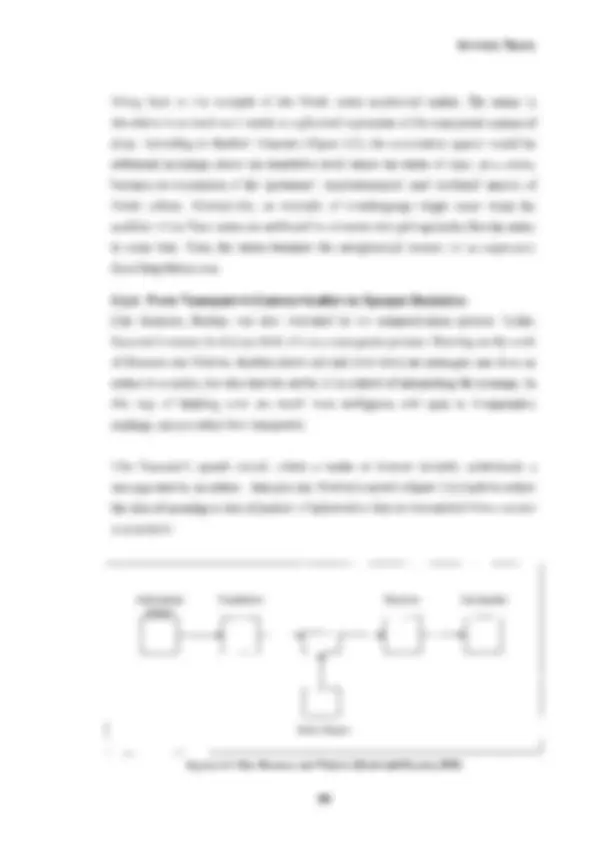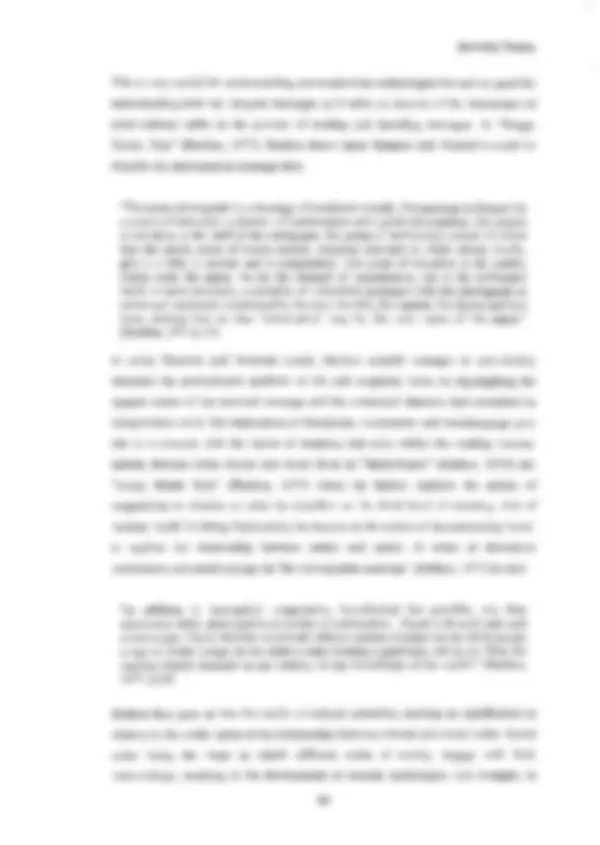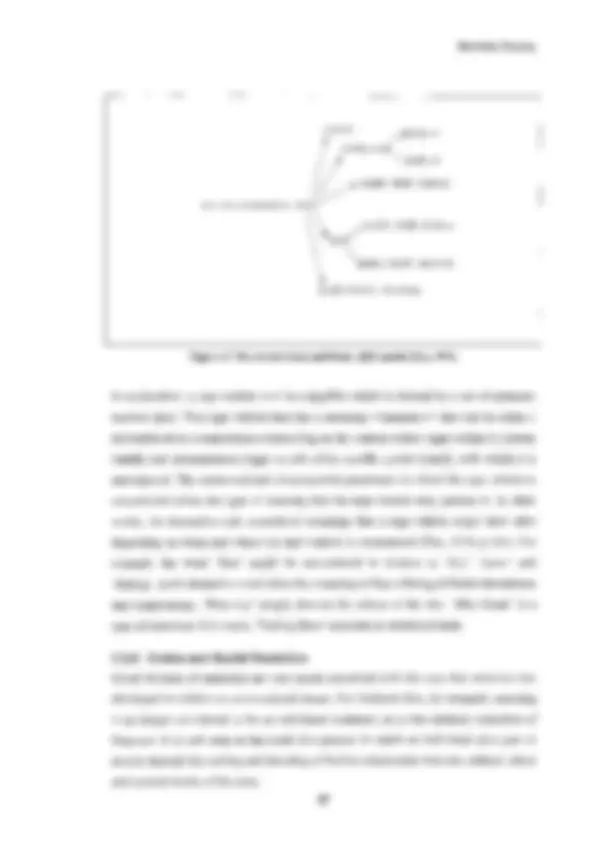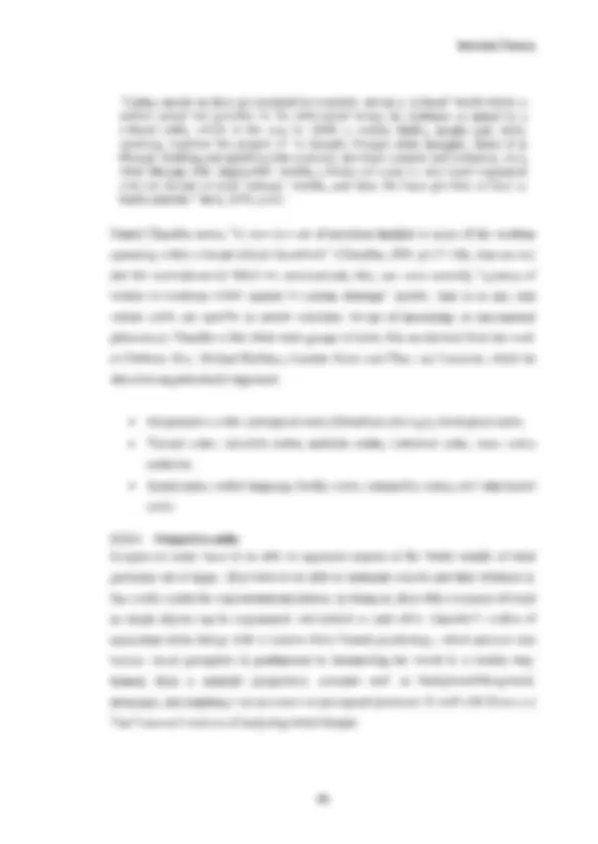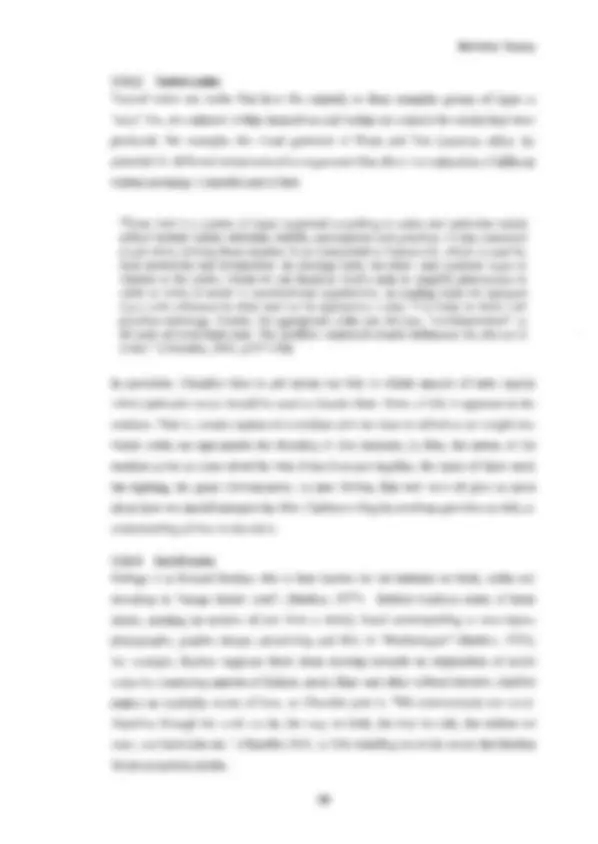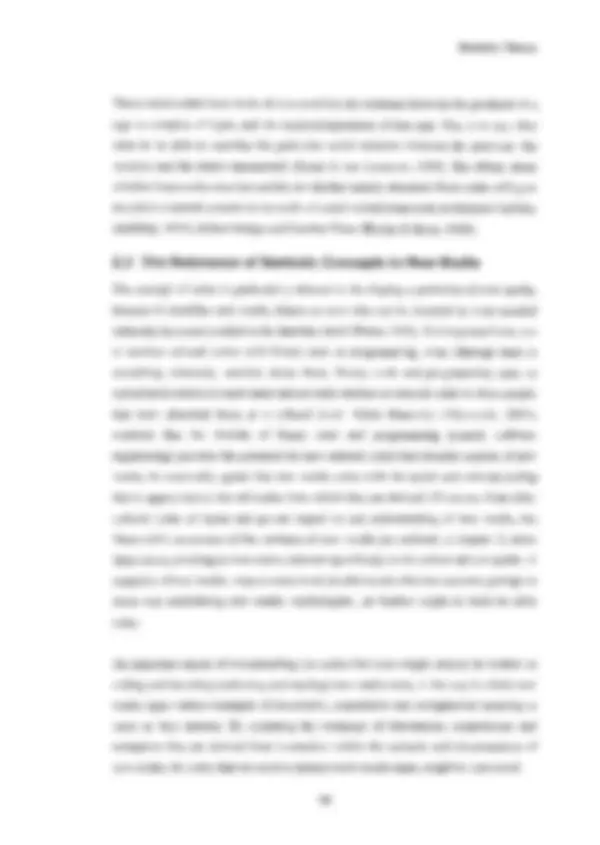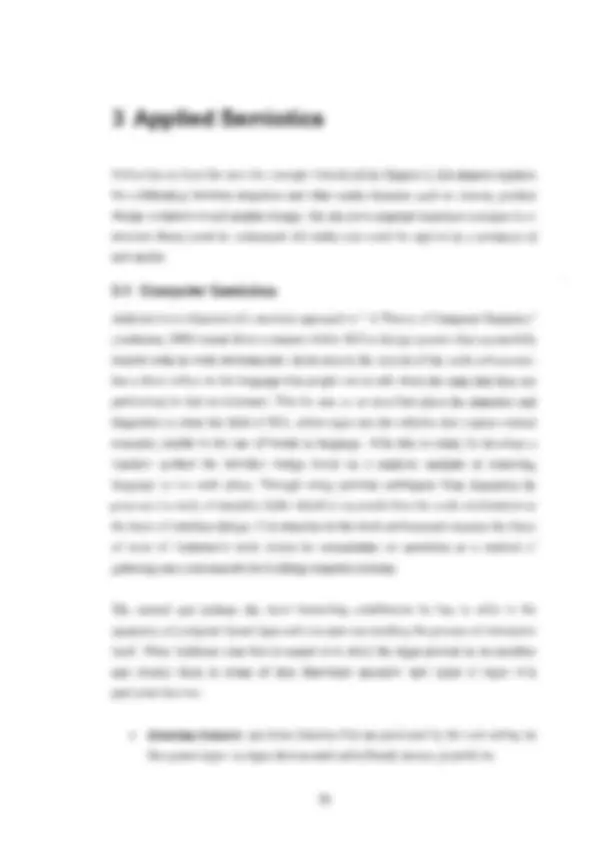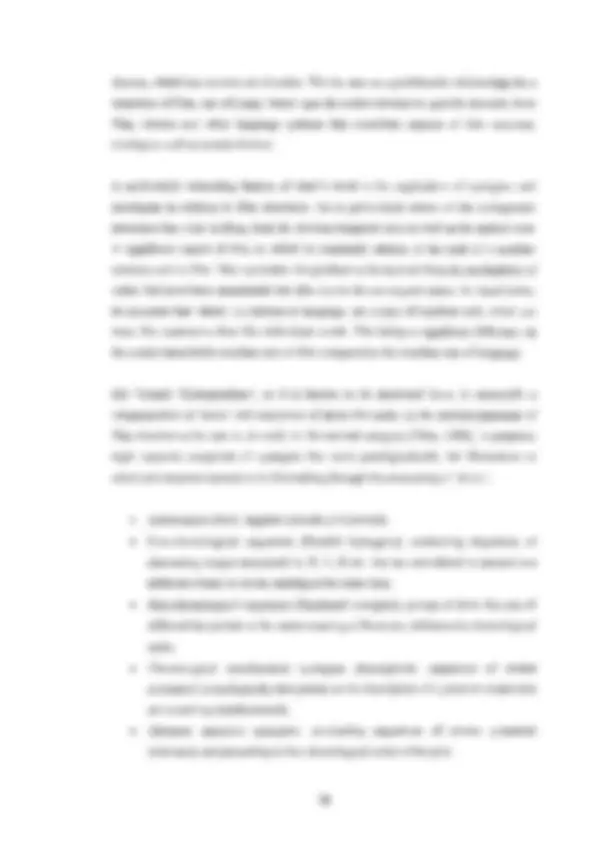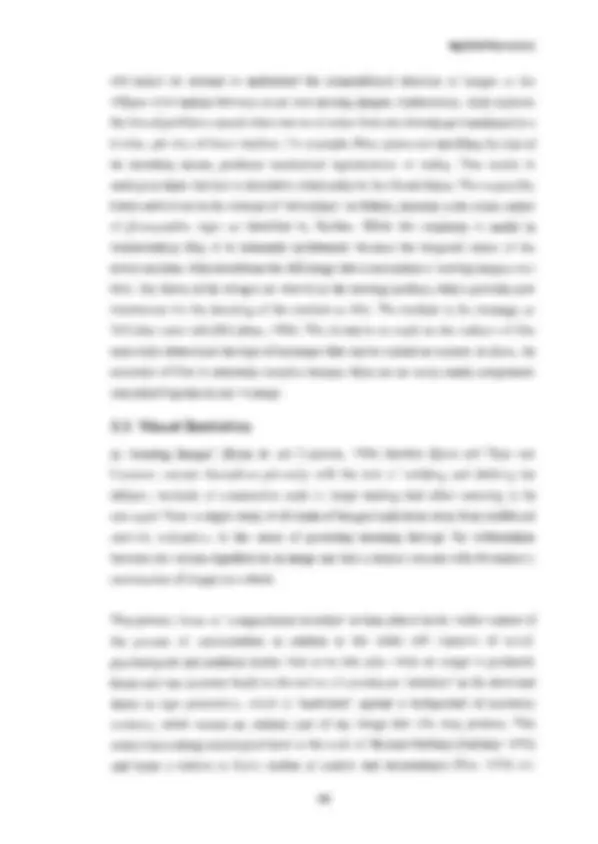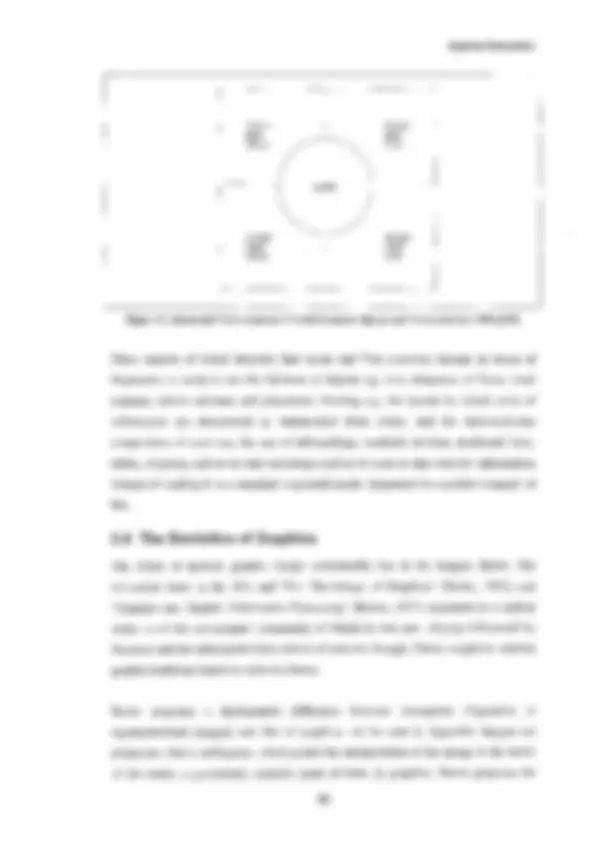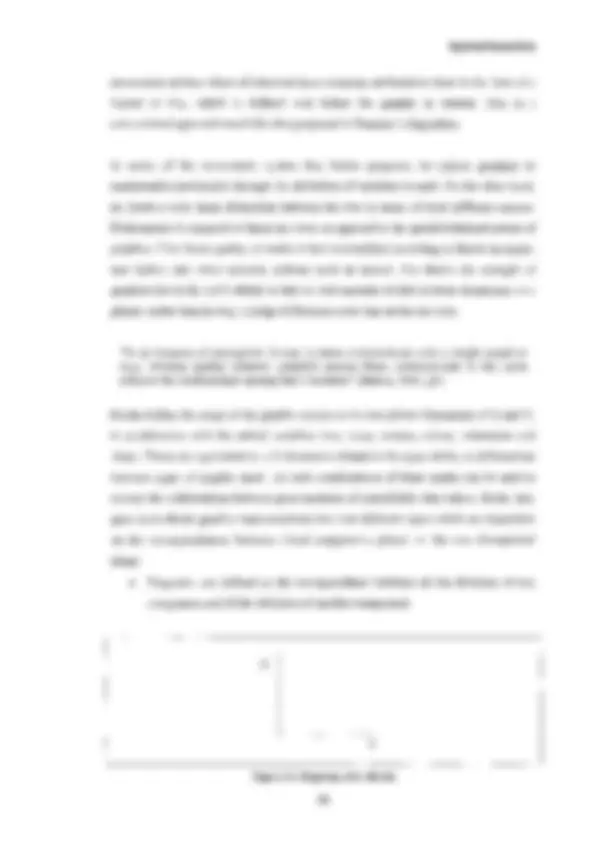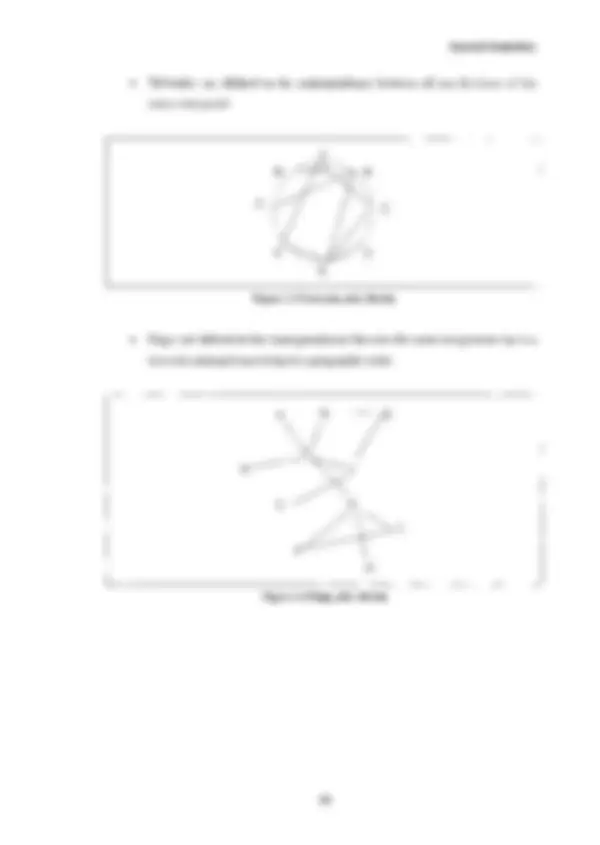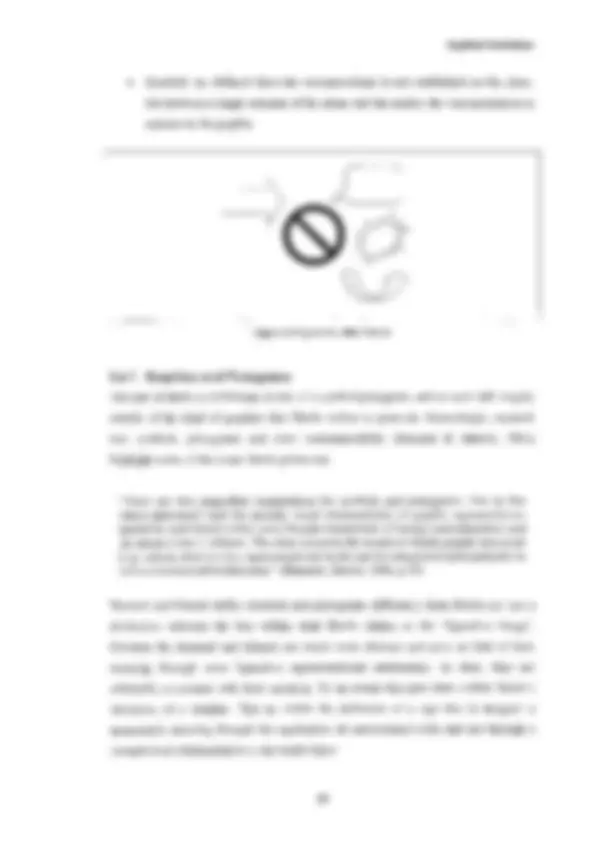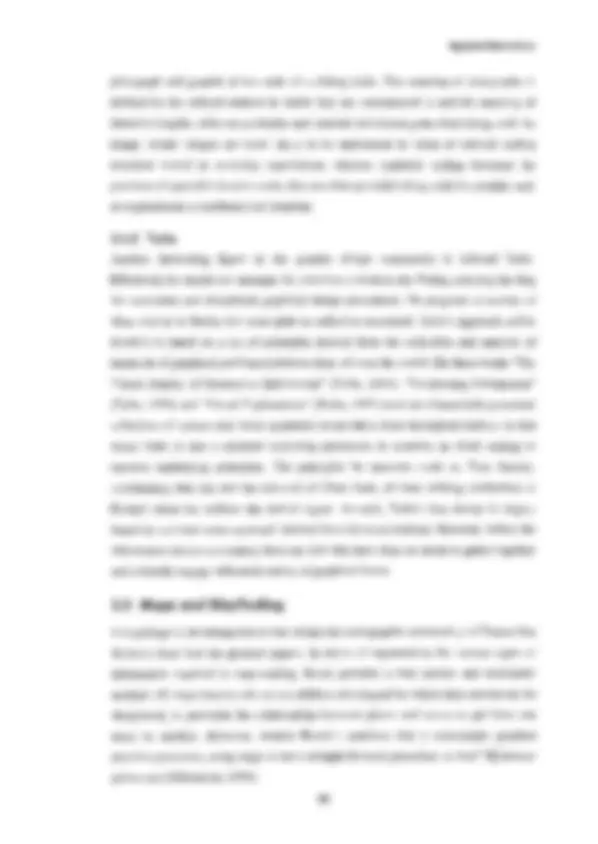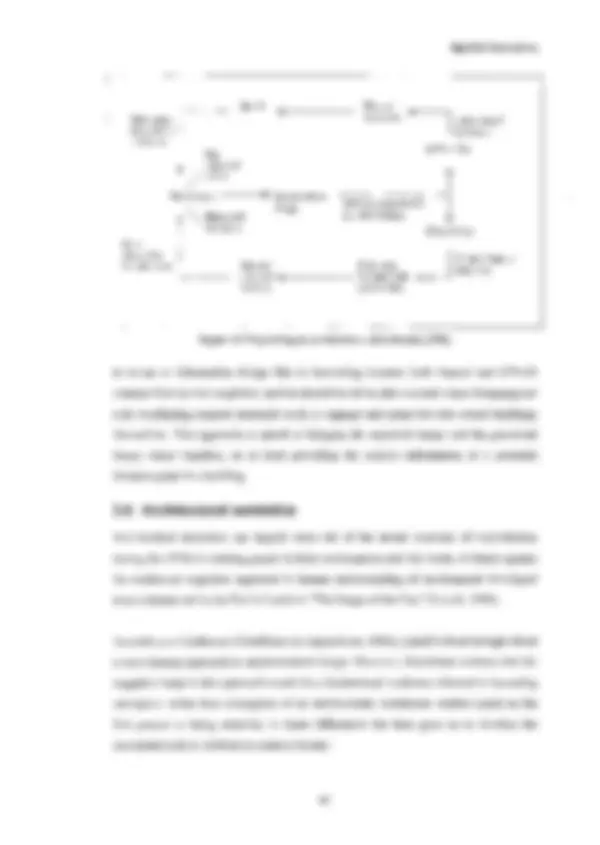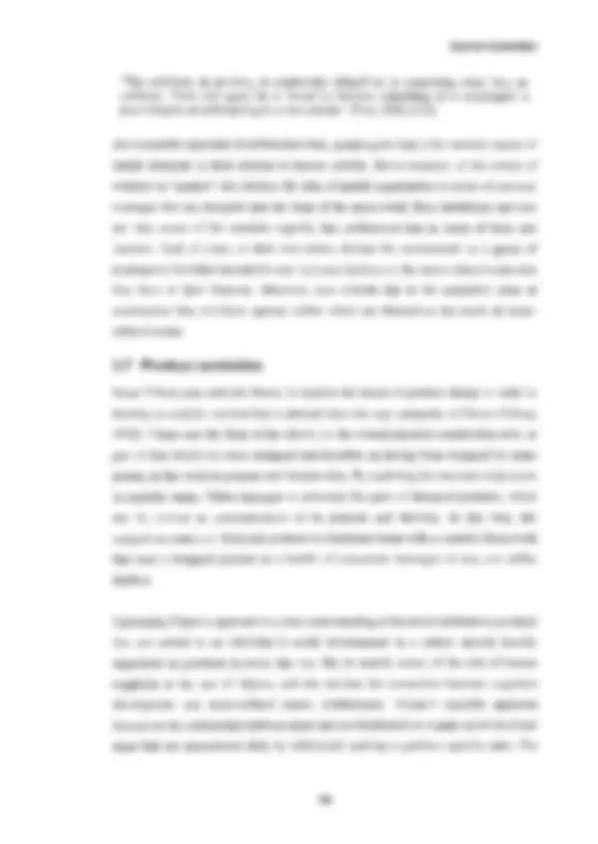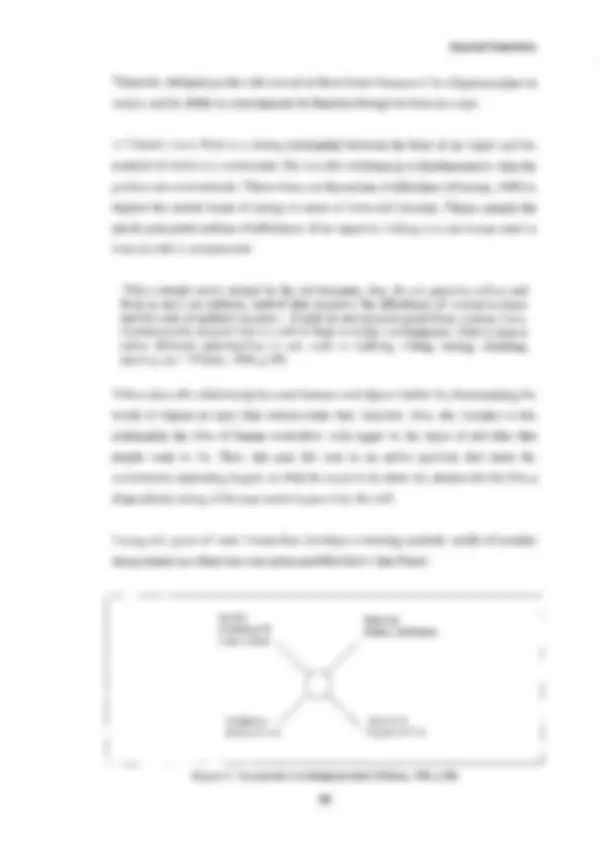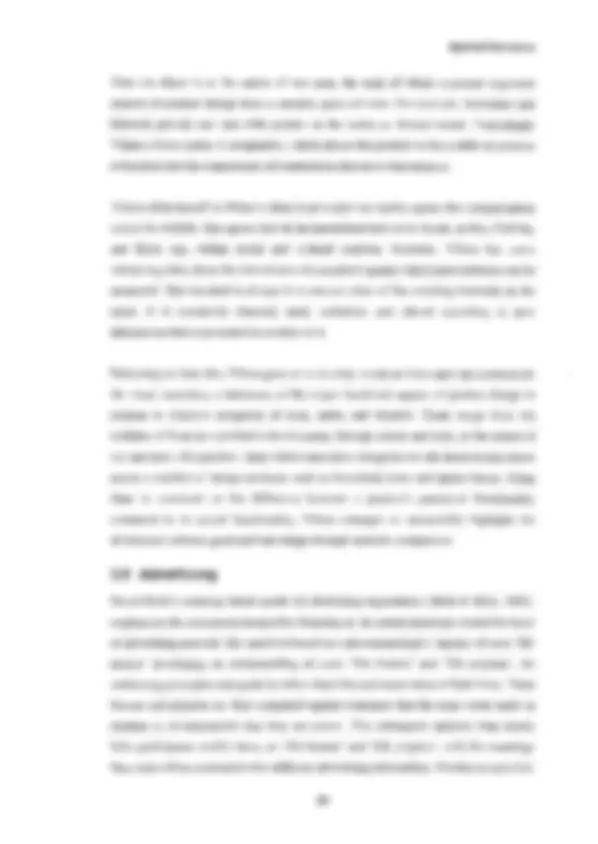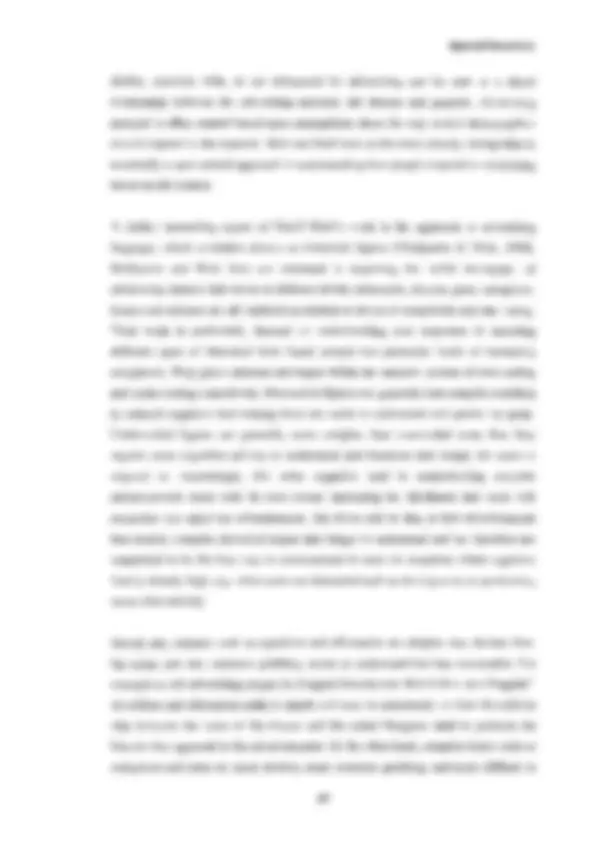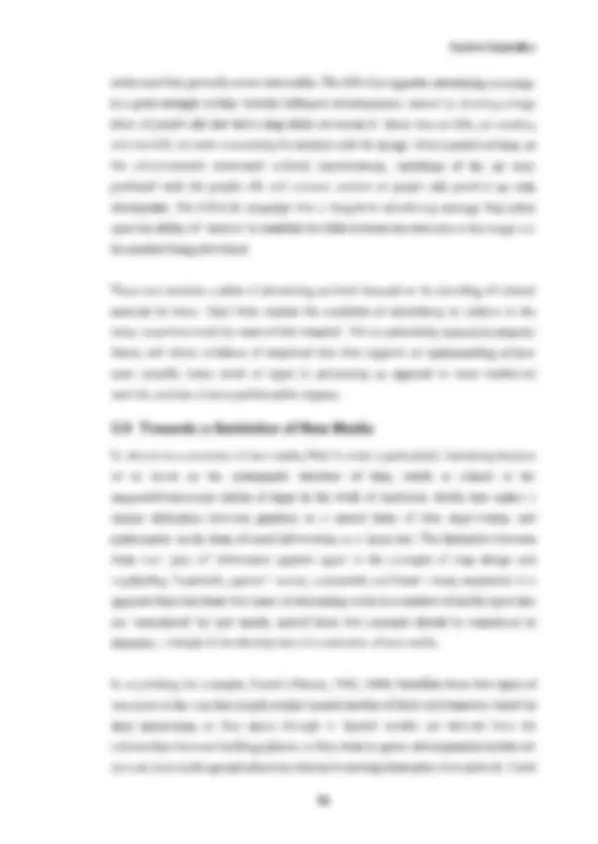Download EXPLORING A SEMIOTICS OF NEW MEDIA and more Exercises Semiotics in PDF only on Docsity!
EXPLORING A SEMIOTICS OF NEW MEDIA
A thesis submitted in partial fulfilment of the
requirements of Napier University for
the degree of Doctor of Philosophy
in Computer Science
Shaleph John O'Neill
School of Computing
Napier University
Edinburgh, UK
In memory of my father
- List of Figures ............................................................................................... - List of Tables - Publications - Acknowledgments - Abstract ......................................................................................................... - Introduction
- Research Questions ........................................................................................ - Question - Question - Question
- The contribution to knowledge made in this thesis
- The Thesis Structure ....................................................................................... - Chapter 1 New media and HCI - Chapter 2 Semiotic Theory - Chapter 3 Applied Semiotics - Chapter 4 The Semiotic Analysis of Three Mobile Phones - Chapter 5 An Integrated Semiotic Model of Interaction with New Media - Chapter 6 Methods - Chapter 7 Interacting with the Hypermedia of Photos hop - Chapter 8 Interacting with the Immediacy of Virtual Environments - Chapter 9 Conclusions
- Summary ......................................................................................................... - 1 New Media and HCI .................................................................................
- 1.1 The Avant-Garde and The Birth of New Media
- 1.2 The Computer as Medium ...................................................................... - 1.2.1 An Artistic Medium? - 1.2.2 A Mass Medium? - 1.2.3 A New Medium?
- 1.3 The Characteristics of New Media .......................................................... - 1.3.1 From Old to New Media - 1.3.2 The Digitisation and Abstraction of Older Media Forms - 1.3.3 The Convergence of Multiple Media Forms and Technology - 1.3.4 The Interactive Production and Interpretation of Meaning - 1.3.5 Two Types of New media
- 1.4 Human Computer Interaction .................................................................. - 1.4.1 Cognitive Psychology and HCI - 1.4.2 Conceptual Modelling - 1.4.3 Execution/Evaluation Cycle - 1.4.4 HCI and New Media
- 1.5 The Phenomenology of Being ................................................................. - 1.5.1 Ready-to-hand Vs Present-at-hand - 1.5.2 Authentic Vs Inauthentic Being - 1.5.3 Phenomenology and HCI - 1.5.4 Embodied Interaction
- 1.6 Semiotics ................................................................................................ - 1.6.1 Semiotics and HCI - 1.6.2 Semiotics and New Media (Narrowing the focus)
- 2.1 Basic Semiotic Theory ............................................................................ - 2.1.1 Ferdinand de Saussure - 2.1.2 Saussure's Speech Circuit. - 2.1.3 Syntagmatic and Paradigmatic Dimensions - 2.1.4 Charles Sanders Peirce - 2.1.5 Icon, Index, Symbol
- 2.2 Further Semiotic Theory ......................................................................... - 2.2.1 Louis Hjelmslev - 2.2.2 Denotation, Connotation and Metaphor - 2.2.3 Roland Barthes - 2.2.4 From Transparent Communication to Opaque Mediation - 2.2.5 Umberto Eco - 2.2.6 Codes and Social Semiotics
- 2.3 The Relevance of Semiotic Concepts to New Media
- 2.4 Conclusion .............................................................................................. - 3 Applied Semiotics ...................................................................................
- 3.1 Computer Semiotics ............................................................................... - 3.1.1 Semiotic Engineering Research Group (SERG)
- 3.2 Cinema ...................................................................................................
- 3.3 Visual Semiotics ..................................................................................... - 3.3.1 Visual Grammar
- 3.4 The Semiotics of Graphics ...................................................................... - 3.4.1 Graphics and Pictograms - 3.4.2 Tufte
- 3.5 Maps and Wayfinding .............................................................................
- 3.6 Architectural semiotics ............................................................................
- 3.7 Product semiotics ...................................................................................
- 3.8 Advertising ..............................................................................................
- 3.9 Towards a Semiotics of New Media
- 3.10 Defining what is Relevant to a Semiotics of New Media - 3.10.1 Codes - 3.10.2 Denotation, Connotation and Metaphor - 3.10.3 Rhetoric - 3.10.4 Syntagmatic Structuring - 3.10.5 Sign Types
- 3.11 Summary ..............................................................................................
- 4 Testing Semiotic Analysis on Three Mobile Phones
- 4.1 Rationale .................................................................................................
- 4.2 Product Semiotics Applied to Three Mobile Phones - 4.2.1 Vihma's classification of sign types in relation to product design - 4.2.2 Analysing the GD35 - 4.2.3 Analysing the Nokia - 4.2.4 Analysing the Nokia - 4.2.5 Findings
- 4.3 Visual Semiotics Applied to Phones - 4.3.1 Narrative Processes - 4.3.2 Conceptual Representations - 4.3.3 Analytical Processes - 4.3.4 Representation & Interaction :............................................................................. - 4.3.5 Modality - 4.3.6 Informational Value - 4.3.7 Salience - 4.3.8 Findings
- 4.4 Eco's Revised KF Model Applied to Phone Symbols - 4.4.1 The perceived meanings of phone signs - 4.4.2 Analysis of Interaction Using Eco's Revised KF Model - 4.4.3 Comparisons Across Three Phones - 4.4.4 Findings
- 4.5 Discussion - 4.5.1 Addressing the Problems of New Media - 5 An Integrated Semiotic Model of Interaction with New Media
- 5.1 Semiotics and embodiment.. - 5.1.1 A Motor theory of language - 5.1.2 Embodied Cognition
- 5.2 Building an Integrated Semiotic Model - 5.2.1 Sign Types - 5.2.2 Concurrent and Sequential Syntagms - 5.2.3 The Functional Cycle - 5.2.4 Denotation, Connotation and Metaphor in the Umwelt - 5.2.5 Tying it all Together
- 5.3 Summary - 6 Methods
- 6.1 Approaches to Data Gathering - 6.1.1 Case Studies :............................................................................. - 6.1.2 Ethnographic studies - 6.1.3 Grounded theory studies
- 6.2 Qualitative Data Gathering Methods - 6.2.1 Observation - 6.2.2 Interviews - 6.2.3 Texts - 6.2.4 Audio and Video Transcription - 6.2.5 Multiple methods
- 6.3 Qualitative Methods Involving Semiotics - 6.3.1 Manning's Semiotic Fieldwork Approach - 6.3.2 The Advertising Approach - 6.3.3 The SERG Approach - 6.3.4 Other approaches exploring semiotics and metaphor in HCI.
- 6.4 Establishing a research strategy - 6.4.1 Study 1: Interacting with the Hypermediacy of Photoshop - 6.4.2 Study 2: Interacting with the Immediacy of Virtual Environments - 6.4.3 Guiding the Research
- 6.5 Analysis and Coding - 6.5.1 Denotative Coding - 6.5.2 Connotative Coding - 6.5.3 Metaphorical Coding
- 6.6 Reliability and Validity - 6.6.1 Reliability in the proposed studies - 6.6.2 Validity in the proposed studies
- 6.7 Summary - 7 Interacting with the Hypermedia of Photoshop
- 7.1 Outline
- 7.2 Participants
- 7.3 Equipment.
- 7.4 Procedure ...............................................................................................
- 7.5 Logging and Analysing the Video - 7.5.1 Coding - 7.5.2 Range and Frequency
- 7.6 Participant 1 :Owen ................................................................................ - 7.6.1 Observing the Video - 7.6.2 Coding the Zones - 7.6.3 Coding the Utterances - 7.6.4 Range and frequency
- 7.7 Participant 2: Dave ................................................................................. - 7.7.1 Observing the Video - 7.7.2 Coding the Zones - 7.7.3 Coding the Utterances - 7.7.4 Range and Frequency
- 7.8 Participant 3: Diarmid ............................................................................. - 7.8.1 Observing the Video - 7.8.2 Coding the Zones - 7.8.3 Coding the Utterances - 7.8.4 Range and Frequency
- 7.9 Discussion .............................................................................................. - 7.9.1 "What kind of signs do users encounter?" - 7.9.2 "What do users do with these signs?" - 7.9.3 "How do users interpret these signs during interaction?"
- 7.10 Zones ....................................................................................................
- 7.11 Summary .............................................................................................. - 8 Interacting with the Immediacy of Virtual Environments
- 8.1 Background .............................................................................................
- 8.2 Participants .............................................................................................
- 8.3 Equipment. ..............................................................................................
- 8.4 Procedure ...............................................................................................
- 8.5 Logging the Video ...................................................................................
- 8.6 Coding and Analysis ............................................................................... - 8.6.1 Denotative Coding - 8.6.2 Connotative Coding - 8.6.3 Metaphorical Coding
- 8.7 Range and Frequency ............................................................................
- 8.8 Descriptions ............................................................................................
- 8.9 Significance and Meaning .......................................................................
- 8.1 0 Realness ...............................................................................................
- 8.11 Other Aspects of the Experience ..........................................................
- 8.12 Discussion ............................................................................................ - 8.12.1 "What kind of signs do users encounter?" - 8.12.2 "What do users do with these signs?" - 8.12.3 "How do users interpret these signs during interaction?" - 8.12.4 Discussion in Relation to Presence - 8.12.5 Immediacy and zones of interaction
- 8.13 Summary .............................................................................................. - 9 Conclusions
- 9.1 The Contribution to Understanding New Media - 9.1.1 The identification of semiotic concepts relevant to new media - 9.1.2 The development of a semiotic model of interaction - 9.1.3 The development of a semiotically informed method of analysis - 9.1.4 The identification of codes
- 9.2 The Contribution to Semiotics .................................................................
- 9.3 Reflections on the Application of the Method
- 9.4 Future work ............................................................................................. - 9.4.1 A three zone model of interaction - 9.4.2 Designer/User relationship - 9.4.3 Design Practice
- 9.5 Conclusion .............................................................................................. - References ....................................................................................................
- Appendix A ....................................................................................................
- Appendix B ....................................................................................................
- Appendix C ....................................................................................................
- Appendix D ....................................................................................................
- Figure 1.1 The Model Human Processor (Card et ai, 1983) List of Figures
- Figure 2.1 Saussure's Sign (Saussure, 1966)
- Figure 2.2 Saussure's 'speech circuit' model of communication
- Figure 2.3 The triadic relationship of the sign (Peirce, 1931-58)
- Figure 2.4 Hjelmslev's model of the sign (Hjelmslev, 1961 ) - (Cobley, 1996) ............................................................................................. Figure 2.5 Barthes' Model of Denotation Connotation and Metalanguage
- Figure 2.6 After Shannon and Weaver (Heath and Bryant, 2000)
- Figure 2.7 The revised Katz and Fodor (KF) model (Eco, 1976) - Leeuwen, 1996 p208) .................................................................................. Figure 3.1 Kress and Van Leeuwen's Visual Grammar (Kress and Van
- Figure 3.2 Diagrams, after Bertin ........................................................................
- Figure 3.3 Networks, after Bertin ........................................................................
- Figure 3.4 Maps, after Bertin ..............................................................................
- Figure 3.5 Symbols, after Bertin
- Figure 3.6 Wayfinding in Architecture, after Passini (1992)
- Figure 3.7 Dimensions of a design product (Vihma, 1994, p 50)
- 6150 ............................................................................................................. Figure 4.1 Three phones: the Panasonic GD35, Nokia 5110, and the Nokia
- Figure 4.2 Multilevel taxonomy in the GD35 phone
- Figure 4.3 The semantic field of the arrow signs on the GD35.
- Figure 4.4 The Semantic Field of 'C' on the GD35
- Figure 4.5 The extended semantic Field of 'C' on the GD35
- Figure 4.6 The semantic Field of an unknown sign
- due to space restrictions) ............................................................................. Figure 4.7 The Main screen of the GD35 (Note: all diagrams omit connotations
- Figure 4.8 Menu screen ......................................................................................
- Figure 4.9 The menu screen stage 2 ..................................................................
- Figure 4.10 The menu screen stage 3. - button ........................................................................................................... Figure 4.11 A functional model of meaning for the Panasonic GD35 Select
- Figure 4.12 A functional model for the Nokia 5110 Select button.
- Figure 4.13 A functional model of the GD35 Navigation button
- Figure 4.14 A functional Model of the Nokia 6150 navigation button
- Figure 4.15 The contextual functional relationships of the 'C' button
- Figure 4.16 Metasymbolic aspects of Select signs
- Figure 4.17 Metasymbolic aspects of navigation signs - 1979) ........................................................................................................... Figure 5.1 Uexkull's functional cycle. (After Uexkull 1957: adapted from Sebeok,
- Figure 5.2 Conceptual Integration (Fauconier and Turner, 2001)
- Figure 5.2 Information artefacts organised in a medium
- Figure 5.3 Concurrent and sequential structures within a medium
- Figure 5.4 The functional cycle between artefacts and meanings
- Figure 5.5 The functional cycle looping over time
- Figure 5.6 Denotation, Connotation and Metaphor in the Umwelt
- Figure 5.7 A semiotic model of interaction with a digital medium
- Figure 7.1 Section of initial video observation notes for Diarmid
- Figure 7.2 The range of codes from Owen's utterances in zone
- Figure 7.3 The range of codes from Owen's utterances in zone
- Figure 7.4 The range of codes from Owen's utterances in zone
- Figure 7.5 The range of codes from Dave's utterances in zone
- Figure 7.6 The range of codes from Dave's utterances in zone
- Figure 7.7 The range of codes from Dave's utterances in zone
- Figure 7.8 The range of codes from Diarmid's utterances in zone
- Figure 7.9 The range of codes from Diarmid's utterances in zone
- Figure 7.10 The range of codes from Diarmid's utterances in zone
- Figure 7.11 A proposed model of zones and meaning
- Figure 8.1 Using the Benogo system ..................................................................
- Figure 8.2 Coded responses from the description probe
- Figure 8.3 Coded responses from the significance and meaning probe
- Figure 8.4 Coded responses from the realness probe
- Figure 8.5 Coded responses from the experience probe
- Figure 9.1 A semiotic model of interaction with new media
- Figure 9.2 A proposed model of zones and meaning
- Table 6.1 Empirical work presented in this thesis List of Tables
- Table 6.2 An example of denotative coding from study
- Table 6.3 An example of connotative coding from study 1..................................
- Table 6.4 An example of metaphorical coding from study
- Table 7.1 Logged and coded Transcript of Owen's utterances
- Table 7.2 Owen's zone/time chart .......................................................................
- Table 7.3 The frequency of codes from Owen's utterances in zone
- Table 7.4 The frequency of codes from Owen's utterances in zone 2.
- Table 7.5 The frequency of codes from Owen's utterances in zone
- Table 7.6 Logged and coded Transcript of Dave's utterances
- Table 7.7 Dave's zone/time chart ........................................................................
- Table 7.8 The frequency of codes from Dave's utterances in zone
- Table 7.9 The frequency of codes from Dave's utterances in zone
- Table 7.10 The frequency of codes from Dave's utterances in zone
- Table 7.11 Logged and coded Transcript of Diarmid's utterances
- Table 7.12 Diarmid's zone/time chart ..................................................................
- Table 7.13 The frequency of codes from Diarmid's utterances in zone
- Table 7.14 The frequency of codes from Diarmid's utterances in zone
- Table 7.15 The frequency of codes from Diarmid's utterances in zone
- Table 8.1 Type and frequency of descriptive codes
- Table 8.2 Type and frequency of significance and meaning codes
- Table 8.3 Type and frequency of realness codes
- Table 8.4 Type and frequency of experience codes
Publications
Listed below are the publications written by the author of this thesis in collaboration with his supervisors Prof. David Benyon and Dr. Susan Turner. All of the publications listed below are directly related to this thesis.
O'Neill S. J., McCall R G. (2004) Measuring Presence in Virtual Environments: Demo 1 The Botanic Garden, Video, CHI2004 proceedings CD2, CHI2004 Vienna, Austria. O'Neill, S. J., & Benyon, D. R. (2004). Semiotics, HCI and the Avant-Garde. Paper presented at the WS#18. Reflective HCI: Towards a Critical Technical Practice, CHI2004, 24-29th April 2004, Vienna, Austria. O'Neill, S. J., (2003). Theory and Data: The Problems of Using Semiotic Theory in HCI Research. Paper presented at the 7th Human Centered Technology Workshop, 15-16 December 2003, University of Sussex, Brighton, UK. O'Neill, S. J., & Benyon, D. R. (2003). An Exploration of a Semiotic Model of Interaction Through Interactive Media. Paper presented at the the International HCI, Arts and Humanities workshop, 21st July 2003, University of York, York, UK. O'Neill, S., & Benyon, D. (2003). A Semiotic Approach to Investingating Presence. Paper presented at the COSIGN-2003, Middlesborough. O'Neill, S., Benyon, D. R, & Turner, S. R (2002). Semiotics and Interaction Analysis. Paper presented at ECCE 11, Catania Sicily. O'Neill, S., Benyon, D. R, & Turner, S. R (forthcoming). The Semiotics of Interactive Systems. To appear in Cognition, Technology and Work.
Abstract .........................................................................................................
New technology is transfonning our world by providing new mediating and
communicating opportunities. Expert critical opinion highlights that these new media are essentially a refonnulation of older media that have been transfonned by integration with computers. Arguably, these transfonnations in media result in transfonnations of the familiar signifying systems that surround us. Thus, a semiotics of new media must
be explored in order to understand how we interact with these new media sign systems.
In proposing a semiotics of new media, this thesis re-evaluates the basics of semiotic
theories and their application in numerous older media domains. The specific problems of interaction with new media are considered, then a solution is proposed in relation to
notions of embodiment and semiotic theory. A semiotic model is then developed that
focuses on interaction and user interpretations of new media sign systems. An argument is also put forward from an embodied/semiotic perspective for a methodological approach that employs the strengths of both.
Empirical studies are conducted that explore the model and ascertain the suitability and robustness of the model when applied to new media systems, such as; mobile phones, the Photoshop desktop application and a novel virtual environment. The critical analysis reveals that the elements in the presented model are indeed relevant. Moreover, the embodied/semiotic method of analysis successfully highlights aspects of participants meaning making activities during new media interactions.
This thesis contributes to an understanding of how users make sense of their interactive encounters with new media sign systems from a semiotic perspective. The semiotic model and the embodied/semiotic method of analysis presented here, are the result of a wide-ranging exploration of semiotic theory in relation to HeI and new media. It is expected that this thesis will be used as the basis for further exploration and future work in this field.
Introduction
The concept of 'new media' is a tricky concept to define. It is not clear when exactly it
came into being, nor is it clear exactly what it means. For example, thinking about new
media gives rise to several questions, such as, how is new media different from old
media? Is it totally different or just marginally different? Similarly, what is new media
about? Logically, the 'new' part of new media essentially refers to the introduction of
new computer technology into previously non-computerised media forms. The 'media'
part refers to those older media forms themselves, e.g. the fine arts, graphic design,
architecture and film. Taken together, the study of new media is essentially about
understanding the transformation from old non-computerised media to new
computerised media. New media then, straddles two major areas of research, computer
science and critical media/art theory.
Within computer science, it is Human Computer Interaction (HCI) that offers a lot in
terms of understanding how people interact with computer systems and new technology.
Over the last 30-40 years HCI has emerged as its own research domain, which
continues to expand its understanding. The traditional HCI approach considers
interaction from a largely cognitive perspective (Dix, Finlay, Abowed, & Beale, 1998),
while others consider HCI in terms of interactive systems design (Benyon, Turner &
Turner, 2004; Preece, Rogers, & Sharp, 2002). Others look for alternative positions
from which to understand interaction with computers, such as the embodied approach of
Dourish (2001) or the experiential approach of McCarthy and Wright (2004). Thus,
HCI is continually exploring its theoretical positions, as highlighted in official ACM
documents that consider the development of an HCI curriculum (Grover, 2001; Hewett
et aI., 1992). Indeed, wherever computers touch on the activities of humans, HCI is
there to try and understand it.
However, there is something fundamentally different about understanding interactions
with a calculator and understanding interactions with an interactive movie or even
interactive moviemaking software. Clearly, there is much more going on in an
interactive movie than in a calculator. Interacting with an interactive movie involves
Introduction
This question is answered in this thesis through a literature review (Chaps 1,2 and 3),
that explores both the characteristics of new media and how semiotics might be brought
to bear upon them, via an understanding of the semiotics of older media.
Question 2
"How might the concepts identified as relevant to the development of a semiotic theory of new media be combined to produce a model of interaction with new media systems?"
This question is answered in Chapter 4 and 5 specifically, where initial semiotic studies
are conducted and the problems of developing a semiotic model of interaction are
considered in detail. A solution is then proposed, based on theories of embodiment that
are related to semiotics via the work of Jacob von Uexkull.
Question 3
"Can the proposed semiotic theory be applied to the study of new media in order to identify the codes that users employ in understanding their interactions"
This question is driven by a need to explore the proposed model, in relation to two key
types of new media that are identified in the literature review. The answer to this
question is provided by studies that explore user interactions with new media (Chapters 7 and 8), where evidence is found to support the proposal of the model from literature. To this end, the purpose of the studies is to answer three sub questions that aim to:
- Determine through observation and interpretation how messages are defined i.e., what they are, how they are constructed etc.
- Determine what users do with and to such messages.
- Determine what types of meanings are actually generated by the users that manipulate these messages.
The purpose of developing a semiotic model of interaction with new media is to find an analytical framework that treats all interactions across different domains, as the production, manipulation and interpretation of signs. This thesis shows how it is derived theoretically from literature and explored via studies that incorporate real world situations of interaction with different kinds of new media.
Introduction
The contribution to knowledge made in this thesis
As new technology changes the way we interact with the media that surround us, the
sign systems that we recognise are transformed as new signifiers emerge. The question
of how we make sense of these new sign systems is paramount if we are to understand
the changing world around us and the new forms of interaction that are becoming a part
of our daily lives. This thesis makes a contribution to the knowledge of how we
understand these new media systems in a number of ways.
Firstly, this thesis contributes to an understanding of new media, by identifying aspects
of semiotic theory that are relevant to developing a semiotic theory of new media.
Secondly, rooted in the study of sign systems and notions of embodiment, the research
presented in this thesis contributes a semiotic model of interaction with new media that
places the user at the centre of activity engaged in the interpretation of sign systems that
fall into two broad categories; hypermedia and immediacy. Thirdly, this thesis
contributes to HCI through the development of methods of data gathering and analysis
that allow not only a semiotic analysis of systems as texts, but of the meanings users
make as they interact dynamically with those texts.
Ultimately, in doing this research, a critique of semiotic theory in relation to new media
is developed and a fundamental problem emerges, namely, the lack of any pre-existing
semiotic theory that is capable of both theorizing about interactive sign systems or
producing user focused empirical findings. Semiotics has long suffered for its lack of
empirical support for its assertions, in relation to the interpretations of readers. The
research presented here attempts to deal with this problem, by developing an argument
for a semiotic approach that borrows a great deal from the concept of embodiment. In
this way, empirical data gathering and grounded theory are built into an embodied
semiotic understanding of user interactions. This in itself can be considered as a
contribution to semiotic theory, simply because there is such a lack of research that
attempts to bridge the theoretical/empirical gap (Chandler, 2002) (Mick & Buhl, 1992).
The Thesis Structure
Chapter 1 New media and HCI This chapter identifies the problem domain in relation to understanding new media. It explores the existing literature in the field, and is an attempt to identify what new media
Introduction
relation to embodiment. The model is an attempt at synthesising theories via the ideas
of Jakob von Uexkull (Sebeok, 1979), that produces a unique framework for
understanding interaction with new media that focuses on the interpretation and
manipulation of signs by an embodied user.
Chapter 6 Methods
This chapter outlines the methodological approach used in the studies conducted for this
research. It develops the argument for a qualitative semiotic data gathering approach to
exploring the meanings that users develop and use during interaction. It also deals with
the practical issues of developing a method of investigation and sets the ground rules for
the following studies, combining phenomenological data gathering techniques and
analysis using semiotic theory.
Chapter 7 Interacting with the Hypermedia of Photoshop This chapter is a detailed qualitative analysis of three individual user studies. It links the
proposed model with data from the real world and it uncovers some of the codes that
users employ while interacting with new media systems of this kind. Also, three zones
of interaction emerge from the grounded aspects of this study, which was something
that was not expected at the outset. These zones are considered in relation to the
purpose of this thesis, but not explored in depth. As such, they offer the starting point
for further work beyond the remit ofthis thesis.
Chapter 8 Interacting with the Immediacy of Virtual Environments This chapter is an attempt at a further exploration of the model in relation to a virtual environment that promotes immediacy. New media that promote immediacy behave differently from those that are based on hypermedia. The exploration highlights some of these differences, while providing further evidence for the proposed model and uncovering further user codes employed in understanding the virtual environment.
Chapter 9 Conclusions In this chapter the answers to the research questions are discussed in relation to the development of a semiotics of new media. All the studies are evaluated in relation to the model and future work is proposed that might include further evaluations of the model in different domains. The evolution of the model is also proposed that might include the zones and meanings, as well as a proposal for understanding the user/designer relationship from a semiotic perspective.
Introduction
Summary
The thesis presented here starts from the premise that new technology is transforming
the world around us, by providing new mediating and communicating opportunities. It
then goes on to propose that these transformations in media result in transformations of
the signifying systems that we use in our daily lives. Therefore, a semiotics of new
media must be explored. In proposing a semiotics of new media, this thesis re-evaluates
the semiotics of numerous old media domains. In doing so, the thesis presents a list of
criteria that should be included in a semiotic theory of new media. This set of criteria is
then developed into a semiotic model of new media that specifically deals with the
problems of interaction and the interpretation of interactive sign systems. Empirical
studies are conducted to explore the model and ascertain the suitability and robustness of the semiotic criteria within the model when applied to real world new media interactions. This thesis contributes to an understanding of how users make sense of their interactive encounters with new media sign systems from a semiotic perspective.

